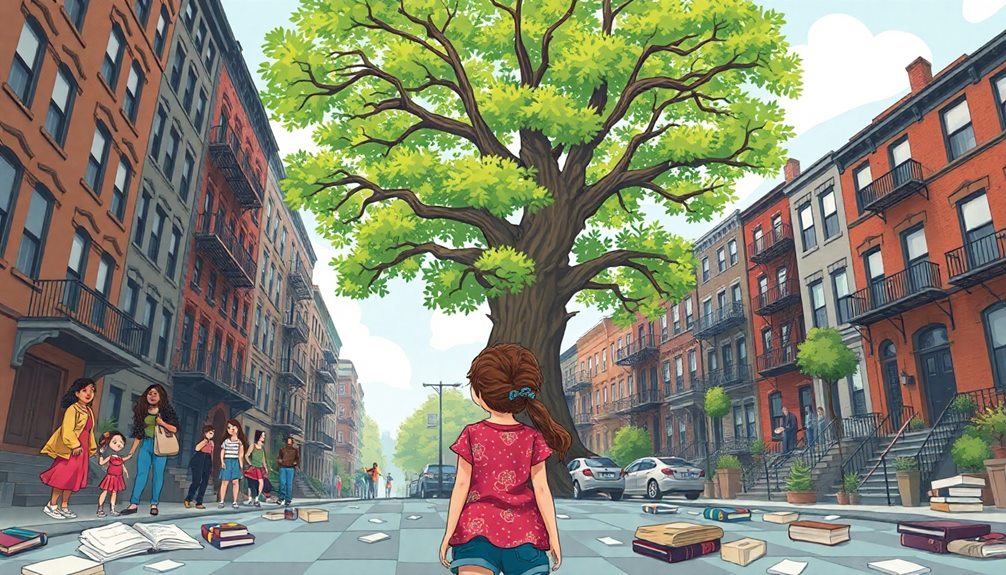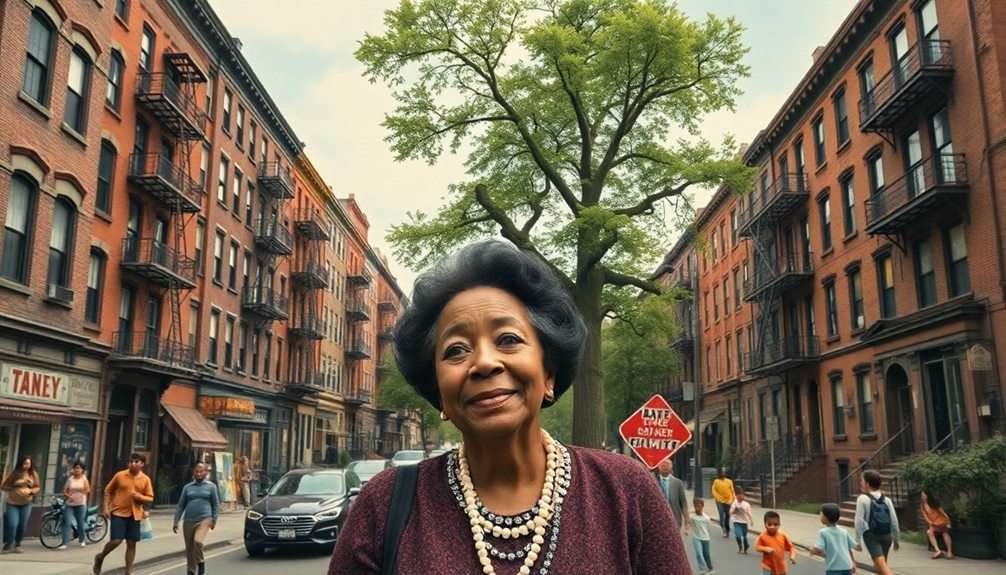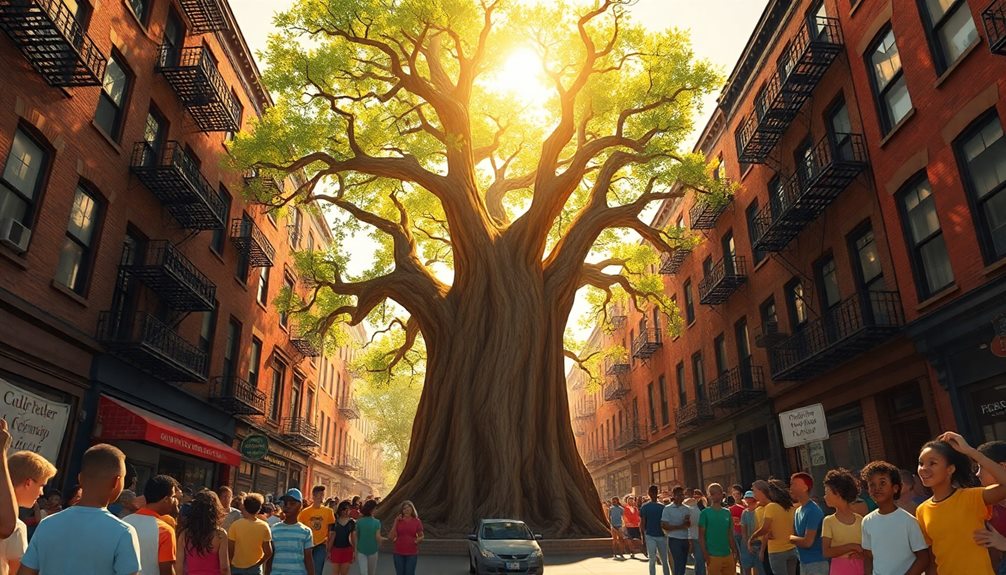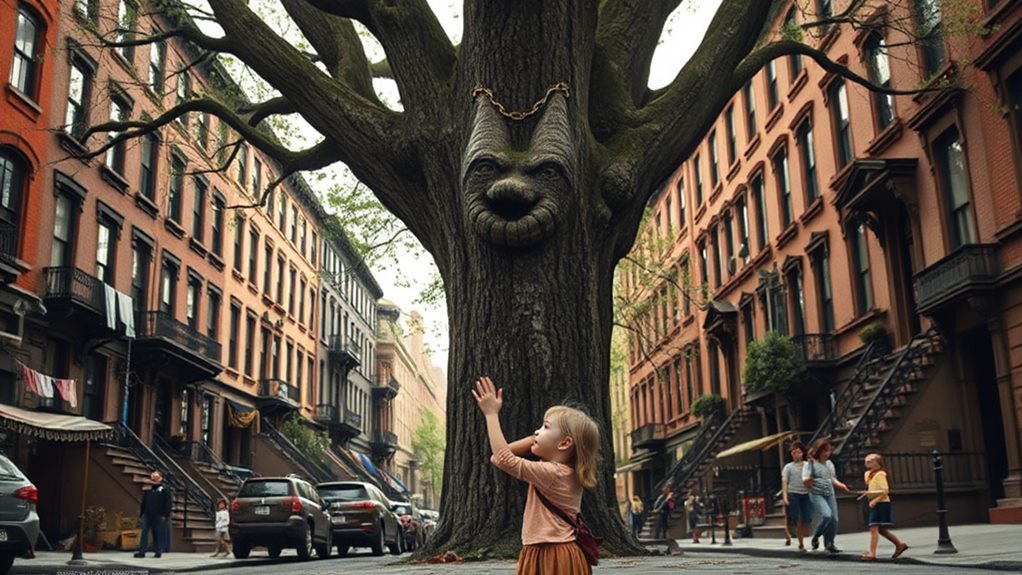*A Tree Grows in Brooklyn*, written by Betty Smith, follows young Francie Nolan as she navigates life in early 20th-century Brooklyn. You'll see how her dreams clash with the hard realities of urban poverty and immigrant struggles. Themes of resilience and ambition shine through Francie's determination to pursue education despite her family's challenges. The Tree of Heaven symbolizes hope and growth, mirroring Francie's journey. As you explore the rich character dynamics and historical context, you'll uncover the deep emotional currents that make this novel a timeless classic, resonating with many who face adversity today.
Overview of the Novel
*A Tree Grows in Brooklyn*, published in 1943 by Betty Smith, captures the gritty yet hopeful life of young Francie Nolan and her family in early 20th-century Williamsburg, Brooklyn.
Set against a backdrop of immigrant diversity, the novel vividly portrays the struggles of urban poverty and societal challenges faced by the Nolan family and their neighbors. You'll find yourself immersed in Francie's coming-of-age journey as she navigates her family's struggles to live amid poverty.
The novel highlights the importance of education and ambition, showcasing how Francie's love for reading and writing becomes her lifeline, offering a way to escape her circumstances. Education emerges as a central theme, emphasizing its role as a means to break the cycle of poverty and achieve a brighter future the immigrant experience.
The Tree of Heaven, a central symbol in the story, represents resilience and the possibility of growth despite harsh conditions. Francie's journey mirrors this tree, as she learns to thrive in a world filled with challenges.
The narrative also explores family dynamics, illustrating how relationships evolve under the weight of financial strain and societal expectations. You'll witness the immigrant experiences that shape their lives, revealing the impact of class and gender roles during that era.
Celebrated for its emotional depth, *A Tree Grows in Brooklyn* resonates with readers, and it's no wonder it's included in high school and college curricula.
Main Characters
In the heart of *A Tree Grows in Brooklyn*, the main characters come alive, each representing different facets of resilience and aspiration. At the center is Francie Nolan, a bright and ambitious young girl whose dreams of becoming a writer push her to seek education despite her family's poverty.
Much like Liesel Meminger in *The Book Thief*, Francie's love for literature serves as a source of hope and empowerment in her challenging environment, reminding readers of the power of storytelling.
Her mother, Katie Nolan, embodies hard work and determination, tirelessly working to provide for her family while facing the harsh realities of life in a tenement.
Johnny Nolan, Francie's father, adds complexity to their lives. While he loves his family, his struggles with alcoholism often lead to financial instability, impacting the emotional dynamics at home.
In contrast, Neeley Nolan, Francie's younger brother, provides sibling support, showcasing a different response to their shared hardships and aspirations.
Key Themes

In "A Tree Grows in Brooklyn," you'll see how poverty shapes the characters' lives and fuels their resilience, much like Louis Zamperini's survival story during WWII, which emphasizes hope and determination.
The struggle for education and ambition stands out as a vital theme, illustrating how knowledge can be a powerful tool for breaking free from hardship, paralleling the insights found in the evolution of societal structures.
As you explore these themes, you'll gain insight into the characters' relentless pursuit of a better life.
Poverty and Resilience
The Nolan family's struggles in "A Tree Grows in Brooklyn" vividly illustrate the harsh realities of poverty and the resilience it demands. You witness through Francie and her mother, Katie Nolan, how financial hardships shape their everyday lives. Despite the unrelenting challenges, they embody resilience and hope.
- Francie's determination: She commits to education as a way to transcend their circumstances.
- Katie's relentless work: She tirelessly provides for the family, showcasing the strength needed to face adversity.
- The Tree of Heaven: This symbol of hope reflects their ability to endure and thrive in a harsh environment.
Together, they navigate their impoverished world, using creative coping mechanisms like celebrating small victories and fostering a love for literacy.
These elements serve as crucial tools in their battle against poverty. The family's journey reveals that while hardships are inevitable, the spirit of resilience can foster growth and hope.
Through their experiences, you see that the pursuit of a better life isn't just a dream—it's a relentless journey marked by determination and strength.
Education and Ambition
Education and ambition serve as lifelines for Francie Nolan in "A Tree Grows in Brooklyn," driving her to rise above the constraints of her impoverished surroundings. Francie's academic aspirations illuminate her path to personal growth, showcasing how education can transform lives.
With her mother, Mary Rommely, emphasizing daily reading, a culture of literacy flourishes in the Nolan household, reinforcing the importance of knowledge.
As you follow Francie's journey, her talent for storytelling emerges as a powerful reflection of her ambition. Writing becomes her means of self-expression, allowing her to document her experiences and navigate her challenges.
Despite the societal expectations weighing heavily on her, Francie's resilience shines through as she pursues her dreams against all odds.
The narrative highlights the empowering role of education, illustrating how Francie harnesses her literacy to conquer adversity. Her story is a testament to the belief that knowledge is a tool for empowerment, offering hope not just for herself but for those around her.
In this way, Francie Nolan embodies the transformative power of education and ambition, inspiring readers to recognize their potential for growth and change.
Historical Context
In "A Tree Grows in Brooklyn," you explore the struggles of immigrant families in early 20th century Brooklyn, particularly during the 1910s and 1920s.
The novel captures the harsh realities of urban poverty and the quest for the American Dream against a backdrop of societal challenges, much like the Joad family's journey during the Great Depression as depicted in the hardships faced by migrant workers.
As you read, you'll see how these experiences reflect the rich cultural tapestry of the time and the resilience of those endeavoring for a better life.
Early 20th Century Brooklyn
Experiencing the vibrant yet challenging life of early 20th century Brooklyn reveals a world shaped by diverse immigrant communities. As you navigate the streets, you'll encounter the struggles and triumphs of families endeavoring for a better life amidst urban poverty.
The Nolans, like many immigrant families depicted in Betty Smith's "A Tree Grows in Brooklyn," showcase the harsh realities of tenement living while chasing the elusive American Dream.
Key aspects that define this era include:
- Cultural Diversity: Brooklyn's immigrant communities—Irish, Italian, German, and Jewish—create a rich tapestry of traditions and values.
- Impact of Industrialization: The growth of factories leads to economic hardships, forcing families to adapt to a new urban lifestyle.
- Public Education: Schools become essential for immigrant families, offering a pathway to social integration and upward mobility.
The early twentieth-century landscape of Brooklyn isn't just a backdrop but a living character that influences family dynamics and shapes aspirations.
Through Smith's lens, you gain insight into the resilience and determination that define this transformative period in American history.
Immigrant Experiences and Challenges
Amidst the backdrop of early 20th-century Williamsburg, the immigrant experience is vividly portrayed through the struggles and aspirations of the Nolan family in "A Tree Grows in Brooklyn." You see how systemic barriers like class prejudice and limited access to education hinder their pursuit of a better life.
The Nolans, representing a melting pot of cultures, navigate the challenges of poverty and societal expectations, reflecting the diverse backgrounds of their community, including Italian, German, Irish, and Jewish influences.
As you explore Francie's story, you witness the resilience that her family embodies despite the harsh realities they face. Economic hardships, intensified by World War I, test their strength and determination.
Yet, the novel emphasizes hope, illustrating how immigrants adapt and cling to their dreams amid adversity. Their experiences highlight the broader immigrant challenges of the time—striving for a better life while overcoming significant obstacles.
Through the lens of the Nolan family's journey, "A Tree Grows in Brooklyn" not only sheds light on individual struggles but also celebrates the cultural diversity that enriches the American experience, making it a poignant reflection on the immigrant experience and the pursuit of the American Dream.
Author's Background

Betty Smith, born Sophina Elisabeth Wehner to German immigrants in Brooklyn, New York, drew heavily from her own life experiences to craft "A Tree Grows in Brooklyn." Growing up in a working-class environment, she faced challenges that shaped her understanding of struggle and aspiration, themes that resonate throughout her novel.
Her resilience mirrors that of many women who've faced adversities, much like those found in the collection of stories featured in impactful narratives highlighting survival and hope.
Her journey into writing began at the University of Michigan, where she won the prestigious Hopwood Award. This achievement fueled her passion for literature and set the stage for her future endeavors.
While juggling various jobs, including waitress and teacher, she honed her craft and reflected the struggles of her characters.
Key aspects of her background include:
- Her roots as the daughter of German immigrants, deeply influencing her storytelling.
- The impact of her working-class upbringing on her writing themes.
- The lasting legacy of her debut novel, which remains a classic.
After "A Tree Grows in Brooklyn," Smith published other works, but none matched the acclaim of her first.
She passed away on January 17, 1972, leaving behind a legacy that continues to resonate with readers today.
Reception and Impact
Published in 1943, "A Tree Grows in Brooklyn" quickly became a commercial success, selling over 4 million copies and solidifying its place as a staple in American literature.
Betty Smith's novel has earned its status as an American classic, recognized for its cultural significance and emotional depth. While it faced initial criticism for being "sentimental," readers have embraced its relatable characters and poignant storytelling.
The book resonates with many, as it tackles themes of poverty and the immigrant experience, similar to how non-fiction literature often brings historical events to life and sparks discussions on social issues that transcend class and race barriers historical narratives challenged.
Its impact is evident in educational curricula, where it's often studied for its rich narrative and depth. Oprah Winfrey has also acknowledged the profound influence of "A Tree Grows in Brooklyn" during her youth, highlighting how it shaped her perspective and continues to inspire readers across generations.
Today, the novel remains a beloved work, celebrated for its authenticity and ability to connect with diverse audiences.
Its enduring legacy showcases the power of literature to reflect and illuminate the human experience, making it a timeless read for anyone looking to understand life's complexities.
Symbolism in the Story

Throughout "A Tree Grows in Brooklyn," symbolism plays an essential role in conveying the novel's themes and character experiences. The Tree of Heaven stands as a powerful emblem of hope and resilience, echoing Francie's determination to thrive despite her challenging surroundings. This theme of resilience resonates similarly to the portrayal of the human spirit in David Copperfield, reflecting how characters grow from their struggles.
Consider these key symbols:
- The Tree: It represents the ability to flourish in adversity, just like Francie's dreams amidst her struggles.
- Francie's Love for Education: Her passion for reading and writing highlights her quest for self-improvement and escape from poverty, showcasing the transformative power of education.
- Family Dynamics: The relationships within the Nolan household symbolize strength and support, illustrating how love can provide comfort in tough times.
As you navigate Francie's world, you'll notice how the recurring motif of hunger—both physical and emotional—intertwines with her artistic ambitions. This contrast between her dreams and the harsh realities of life emphasizes the theme of survival.
Ultimately, the tree serves as a poignant reminder that beauty can indeed emerge from adversity, reinforcing the novel's exploration of hope and the complexities of family dynamics.
Cultural Significance
"A Tree Grows in Brooklyn" holds a significant place in American literature, resonating with readers across generations. Betty Smith's powerful narrative captures the immigrant experience, portraying the struggles of a family facing poverty while working for the American Dream.
Its cultural significance lies in how it explores themes of resilience and hope, making it relatable to many who've faced adversity. Much like Richard Wright's *Native Son*, which also investigates the harsh realities of societal oppression, Smith's work emphasizes the importance of understanding systemic issues affecting marginalized groups, highlighting the complexities of identity and social injustice systemic oppression in literature.
Since its publication in 1943, the novel sold nearly 3 million copies within two years, reflecting its widespread appeal and impact. It's often cited among the "Books of the Century" by the New York Public Library, highlighting its enduring legacy.
The adaptation into a film in 1945 and its inclusion in high school and college curricula further solidify its status as a staple in American literary education.
Notably, influential figures like Oprah Winfrey have acknowledged the profound impact of "A Tree Grows in Brooklyn" on their lives, illustrating its role in shaping cultural narratives.
Ultimately, this classic not only tells a compelling story but also fosters discussions about social issues and identity, making it an essential part of American literature.
Conclusion
To sum up, "A Tree Grows in Brooklyn" beautifully captures the resilience of the human spirit amidst adversity. As you journey through the lives of its characters, you realize that "the apple doesn't fall far from the tree." Betty Smith's novel not only reflects the struggles of a young girl coming of age but also serves as a reminder of the strength found in family and hope. It's a timeless tale that resonates deeply, no matter the era.



